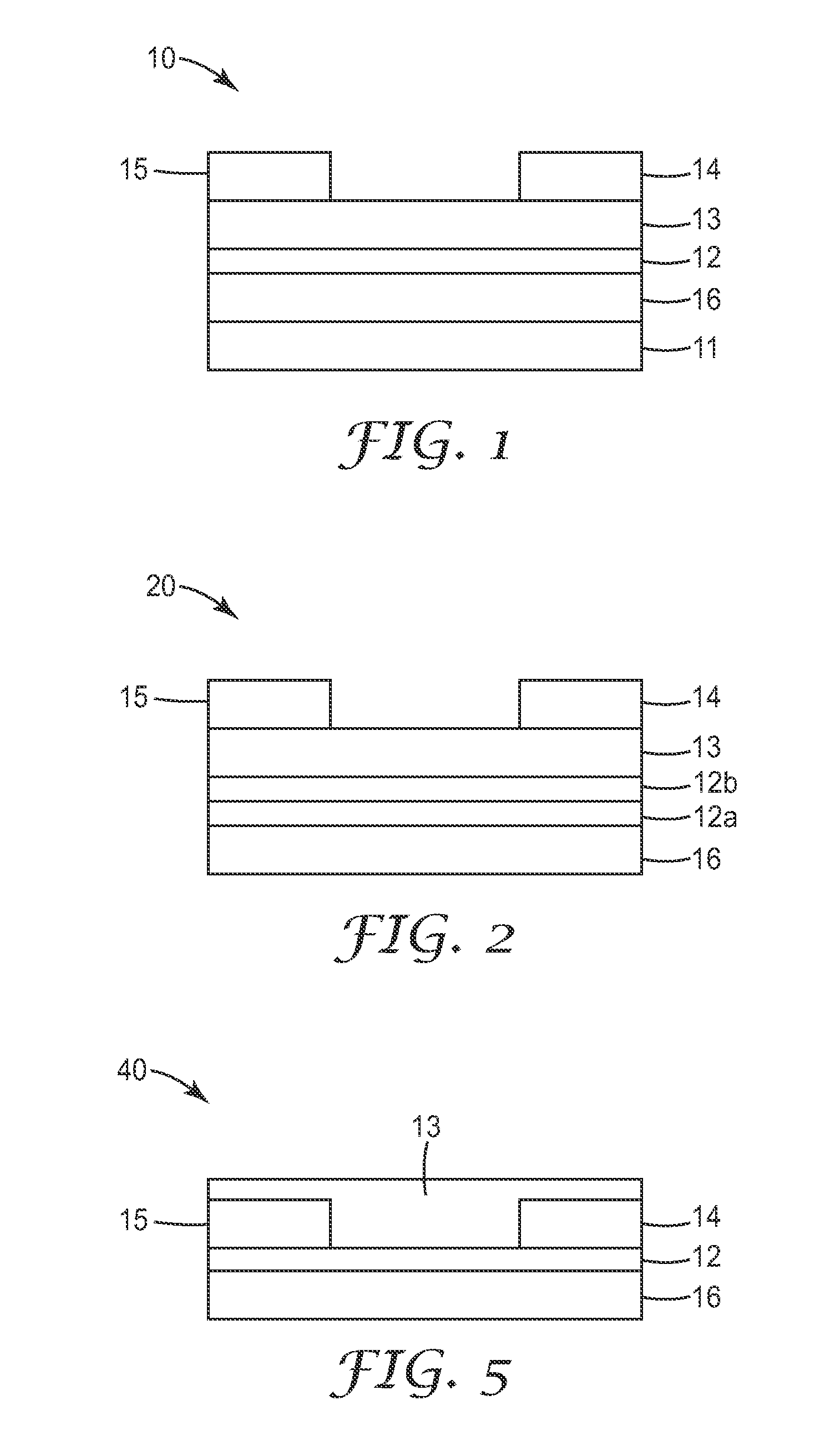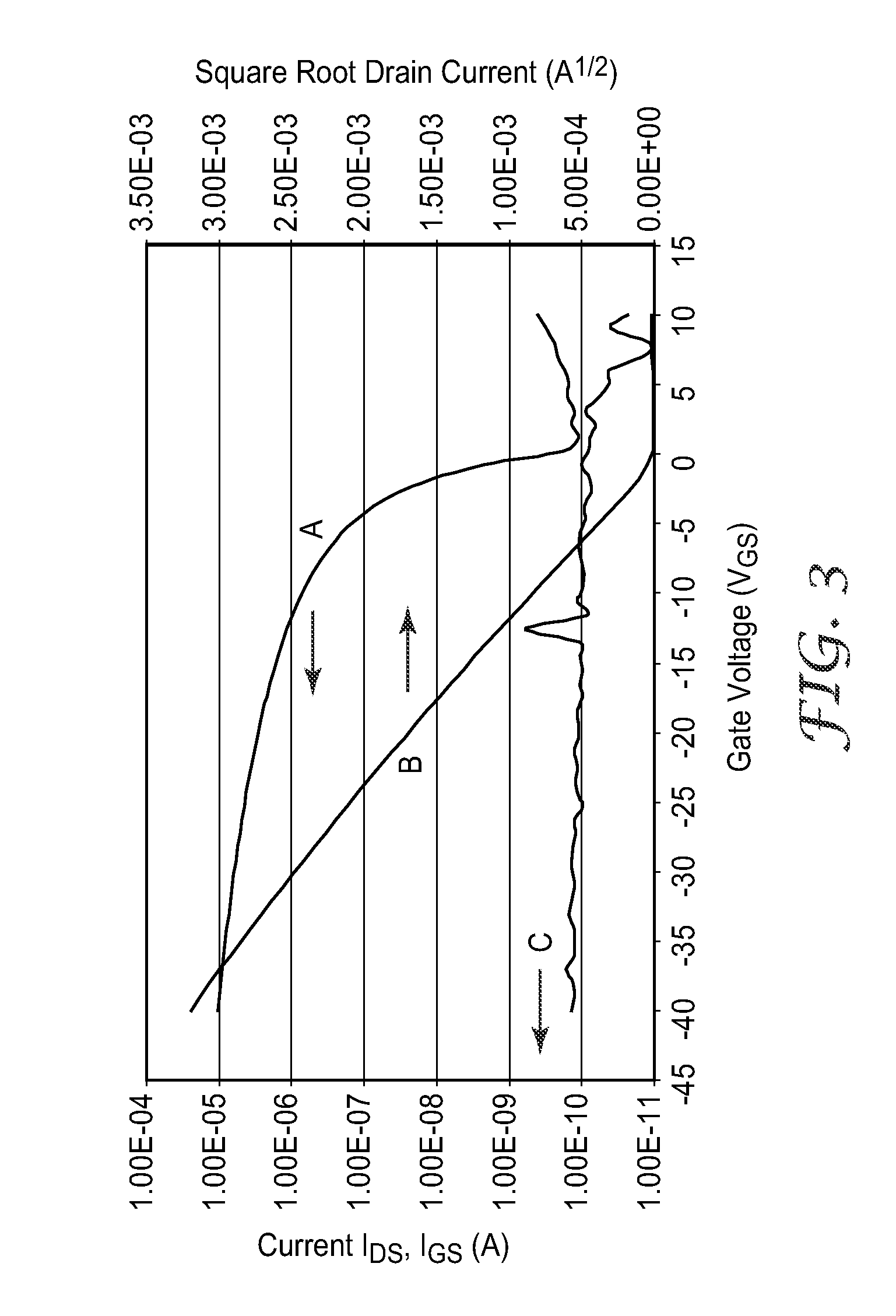Silylethynyl Pentacene Compounds and Compositions and Methods of Making and Using the Same
- Summary
- Abstract
- Description
- Claims
- Application Information
AI Technical Summary
Benefits of technology
Problems solved by technology
Method used
Image
Examples
example 1
Synthesis of 6,13-Bis(allyldiisopropylsilylethynyl)pentacene (Allyl DIPS)
Synthesis of Allyldiisopropylsilyl Acetylene
[0144]Dichlorodiisopropylsilane (4.00 g, 21.6 mmol) and anhydrous THF (20 mL) were added into a dry 250-mL round bottom flask equipped with a stir bar. The flask was equipped with a dry condenser. Allyl magnesium bromide (22.0 mL, 22.0 mmol, 1.0 M in THF) was added to the flask through the condenser to form a first mixture. The first mixture was heated to 63° C. for 12 hours, and then cooled to room temperature.
[0145]Trimethylsilyl acetylene (2.36 g, 24.0 mmol) and anhydrous THF (12 mL) were added to a separate dry 100-mL round bottom flask equipped with a stir bar. The 100-mL flask reaction mixture was cooled to 0° C., and n-butyllithium (9.2 mL, 23 mmol, 2.5 M in hexane) was added dropwise, followed by stirring for 90 minutes to form a second mixture.
[0146]The 250-mL reaction mixture (i.e., the first mixture) was then cooled to 0° C., and the second mixture was adde...
example 2
Synthesis of 6,13-Bis(isopropenyldiisopropylsilylethynyl)pentacene (IP-DIPS)
Synthesis of Isopropenyldiisopropylsilyl Acetylene
[0150]2-Bromopropene (4.32 g, 38.6 mmol) and anhydrous THF (20 mL) were combined in a dry 250-mL round-bottom flask with a stir bar, and then cooled to −78° C. n-Butyllithium (14.8 mL, 37 mmol, 2.5 M in hexanes) was added dropwise. Stirring was continued and the temperature was maintained for 10 minutes, followed by the dropwise addition of dichlorodiisopropylsilane (6.85 g, 37.0 mmol). The mixture was allowed to warm and stirred for 48 hr to form a first mixture.
[0151]In a separate dry 100-mL round-bottom flask with a stir bar, trimethylsilylacetylene (3.93 g, 40.0 mmol) and anhydrous THF (10 mL) were combined and cooled to 0° C. n-Butyllithium (14.8 mL, 37 mmol, 2.5 M in hexane) was added dropwise and stirring was continued for 2 hr to form a second mixture. The first reaction mixture was cooled to 0° C. The second mixture was added to the first mixture by ...
example 3
6,13-Bis(diisopropenylisopropylsilylethynyl)pentacene (DIIP-IPS)
Synthesis of Diisopropenylisopropylsilyl Acetylene
[0155]2-Bromopropene (14.5 g, 120 mmol) and anhydrous THF (100 mL) were combined in a dry 500-mL round-bottom flask with a stir bar, and then cooled to −78° C. n-Butyllithium (47.5 mL, 119 mmol, 2.5 M in hexane) was added dropwise. Stirring was continued and the temperature was maintained for 10 minutes, followed by the dropwise addition of trichloroisopropylsilane (10.5 g, 59.4 mmol). The mixture was allowed to warm and was stirred for 48 hr to form a first reaction mixture.
[0156]In a separate dry 250-mL round-bottom flask with a stir bar, trimethylsilylacetylene (7.37 g, 75.0 mmol) and anhydrous THF (20 mL) were combined and cooled to 0° C. n-Butyllithium (28 mL, 70 mmol, 2.5 M in hexane) was added dropwise and stirring was continued for 2 hr to form a second reaction mixture. The first reaction mixture was cooled to 0° C., then the second reaction mixture was added by...
PUM
 Login to View More
Login to View More Abstract
Description
Claims
Application Information
 Login to View More
Login to View More - R&D
- Intellectual Property
- Life Sciences
- Materials
- Tech Scout
- Unparalleled Data Quality
- Higher Quality Content
- 60% Fewer Hallucinations
Browse by: Latest US Patents, China's latest patents, Technical Efficacy Thesaurus, Application Domain, Technology Topic, Popular Technical Reports.
© 2025 PatSnap. All rights reserved.Legal|Privacy policy|Modern Slavery Act Transparency Statement|Sitemap|About US| Contact US: help@patsnap.com



